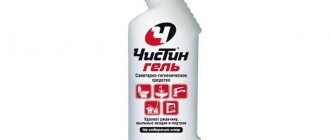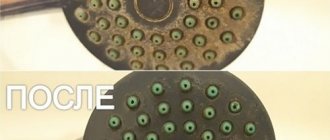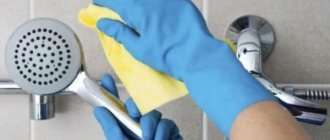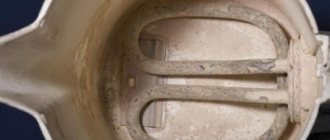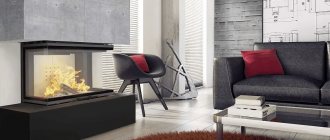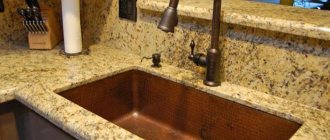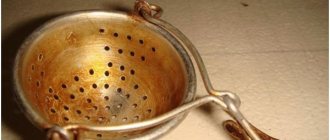How to remove using folk remedies?
The problem of limescale is directly related to the quality of tap water. The salts it contains in large quantities begin to deposit on the glass over time. To dissolve them, simple improvised means can be used.
Vinegar
Acetic acid can be used to remove limescale. Regular table vinegar undiluted or concentrated vinegar essence with the addition of water will do.
Procedure:
- Pour 1 glass of water into the prepared container.
- Add 1 tbsp. l. essences.
- Stir.
- Apply the product using a napkin or spraying from a spray bottle.
- Leave for 15-20 minutes.
- The area with tinder coating.
- The glass is washed off with water and wiped dry.
After treatment with vinegar, a specific odor may remain.
Ammonia
Ammonia is a fairly common remedy for treating dirt and various stains. It is also suitable for removing lime from glass.
For processing, you need to prepare a solution from the following ingredients:
- a glass of warm water;
- 20 ml. ammonia.
The components are mixed and used to wipe off plaque. For best results, it is recommended to keep the composition on the glass for 10-15 minutes.
Ammonia has a specific pungent odor, so it is advisable to carry out the treatment with good ventilation.
Toothpaste
Toothpaste will help remove limescale in small areas. To treat, the paste is squeezed onto a damp brush (or an old toothbrush) and rubbed into problem areas. After 5-10 minutes you will need to repeat the cleaning. After this, the composition is washed off with water and the glass is wiped dry.
Lemon acid
For exposure, it is necessary to prepare a solution from the following components:
- 1 glass of water;
- 1 packet of citric acid.
It is convenient to apply the solution to a large area using a sprayer. After the product has been kept on the glass for a quarter of an hour.
After this, the glass is washed using warm water. It is advisable to use warm water to create the solution - this will increase the cleaning efficiency.
Hydrogen peroxide
The use of pharmaceutical peroxide in the national economy is widespread. It is enough to apply the product on a napkin and wipe the areas affected by lime, moisturizing them well. After 15 minutes, the glass is washed with water and wiped dry.
How to clean different types of glass
Depending on the purpose of the glass, the same cleaning methods show different results. Therefore, a little about how best to wipe different types of glass.
| Glass | Best ways |
| Window | Plaque can be easily removed using store-bought chemicals, laundry soap, ammonia, alcohol, and lemon juice. And dishwashing detergent helps to remove the protective film from a new double-glazed window. |
| Matte | Ammonia, vinegar, chalk solution (3 tablespoons per 1 glass of water), industrial chemicals are effective. Also, frosted glass is difficult to wipe dry. Therefore, methods that do not require rinsing are preferred. Such glasses are usually wiped with microfiber and paper, not cloth. |
| Dishes (glass and crystal) | Vinegar, ammonia and dish gels work best. The main tool is a sponge. And plaque and scale are removed by soaking the dishes in slightly heated vinegar. |
| Shower cabin | Store-bought drugs are the most effective. From home - soap and alcohol (not ammonia). Glycerin and store-bought water-repellent coatings, popularly known as “anti-drip”, are often used. |
How to wash windows without streaks using improvised compounds if there are no special ones?
When planning to wash windows, you should prepare free space - remove foreign objects, remove curtains
It is also important to take care of the tool in advance
Soapy water
Before you start washing the glass itself, you should put the frames, window sills and slopes in order. Soapy water is an effective and simple way to clean windows from dirt and dust without causing scratches.
The soap solution is prepared based on one of the cleaning products:
- grated bar soap;
- washing powder;
- liquid soap;
- dishwashing or laundry gel.
The selected product is carefully diluted in water in an arbitrary proportion. Use the prepared solution to wash the frames. After removing the dirt, the composition is washed off the windows with clean water.
In advanced cases, you can apply the soap solution in advance and give the product time to work. To do this, you can leave the applied product on for 10 minutes. After that, wash the windows.
For heavily soiled glass, you can also use a soap-based cleaner. But it is necessary to take into account that after this the windows will need to be washed off very carefully.
Soda plus vinegar
Using soda in its pure form allows you to wash away dirt, but this method can lead to scratches due to the abrasiveness of the powder. Because of this, the product is not recommended as a stand-alone cleaning agent either for washing frames or for washing glass.
To keep windows clean, a composition containing soda can be used:
- water – 2 liters;
- vinegar - ½ cup;
- soda - ¼ cup.
Lemon
The simplest option:
- Pour a glass of water into a container with a spray bottle.
- Add ¼ cup lemon juice.
- Apply to glass using a spray bottle.
- Wipe with a soft cloth.
You can only use freshly squeezed juice, not canned juice.
Chalk solution
For very dirty windows, a composition based on finely ground chalk will help. If the windows have not been washed for a long time, there are streaks and traces of insects, then the chalk is diluted with water to a paste, and in this water is spread over the glass surface.
As a means of regular treatment, the solution may be less concentrated:
- Pour 0.5 liters of water into a container.
- Add 25 grams of chalk powder.
- Stir until smooth.
- Apply.
- Wait for the composition to dry.
- Wipe with a rag.
- Rinse off.
Instead of chalk, you can use tooth powder.
Glycerol
Glycerin as an independent product is not intended specifically for cleaning windows.
His tasks:
- give the surface shine;
- prevent the appearance of ice;
- reduce the amount of deposited dust.
One of the simple recipes:
- In a small container, mix water (40 ml) and glycerin (60 ml).
- Add 3 drops of ammonia.
- Stir.
- Use to wipe glass.
The composition with glycerin must be rubbed in, leaving no wet areas for it to dry on its own. Read more about the method here.
Blue
Blue is not an independent cleaning agent capable of dealing with complex stains. Adding it in small quantities (a pinch per liter of water) to any homemade window cleaning mixture will allow the glass to acquire an interesting bluish tint.
For washing frames, a composition with blue is not used due to the risk of stains from uneven painting.
Starch
Edible potato starch is one of the products that can be used to deal with dusty windows by washing them without streaks.
A simple and effective recipe includes only 2 components:
- liter of water;
- a tablespoon of starch.
Ammonia
The following use case is suitable for cleaning windows:
- Pour a liter of water into the container.
- Add ammonia - 10 ml.
- Mix.
If the windows are very dirty, you can also add vinegar to the composition. Read more about this method of washing windows here.
Vinegar
A water solution of table vinegar is a good option to wash glass without streaks and clean frames. It should be borne in mind that to clean frames, vinegar should be used only in diluted form, so as not to damage the plastic.
Standard solution preparation option:
- pour ½ liter of water into a container;
- pour in vinegar (1/4 cup);
- pour in dishwashing liquid (1/2 tsp);
- mix.
This publication will tell you more about cleaning windows with vinegar.
Fabric softener
It's very easy to prepare:
- Pour a liter of water into a convenient container.
- Add a glass of conditioner.
- Mix the composition.
- Use with a napkin.
- Polish with a dry cloth.
You can learn more about cleaning windows with fabric softener here.
What to do if stains appear
| Way | Description |
| Soap solution | Prepare according to the recipe outlined above in the article. First, wash the glass with this solution, then immediately with water without additives. Wipe with paper or microfiber. |
| Ammonia, salt, vinegar | Use according to the methods specified in the article. All products are very effective in removing stains. |
| Paper | The glass is washed with clean water, and then wiped dry with paper. Napkins, newspapers, and toilet paper are suitable. |
| Microfiber | If you simply rub glass with stains with a damp microfiber, they will disappear. And the napkin itself does not leave any traces. |
| Alcohol-based window cleaner | Detergent with alcohol will help with seemingly indelible stains. The same inexpensive “Mr. Muscle” will do the job in a few minutes. But it’s better to wipe the window with paper to prevent new marks from appearing. |
Cleaning the walls of the cabin from limescale
The cabin walls are made of plastic or polystyrene. These materials have a microporous structure and therefore accumulate lime deposits faster than others. Over time, surfaces take on an unpresentable appearance. The difficulty of cleaning lies in the fact that plastic cannot be exposed to aggressive detergents (formaldehyde, chemical acids, alkalis), which are often used to remove complex contaminants.
Cleaning the walls of the shower cabin.
It is recommended to use gentle industrial compounds intended for cleaning shower stalls, or folk remedies:
- soda;
- vinegar;
- citric acid;
- ammonia;
- hydrogen peroxide.
The selected product is applied with a soft sponge to a clean, damp surface, left for 10-30 minutes, and then rinsed with warm water. To remove complex contaminants, use a rubber or silicone scraper.
How to remove plaque from glass
To clean glass, it is recommended to use ready-made liquid products, preferably in the form of sprays.
This way they are better applied and evenly distributed over the surface.
Cleaning the walls of the shower stall.
An ammonia (ammonia) solution, which is prepared from the following components, will help to clean the cabin doors from soap stains and add shine:
- ammonia - 25 ml (1 tbsp);
- water at room temperature - 1 l.
Moisten a microfiber cloth in the product and wipe the glass surfaces until there are no streaks left on them. Ammonia has a pungent odor, so treatment should be carried out with the bathroom doors open.
How to prevent lime deposits?
The formation of limescale is a very common problem; the following recommendations will help to significantly reduce the likelihood of its occurrence:
- After glass products come into contact with water, they must be dried. If possible, wipe dry. This will not only allow you to do general cleaning less frequently, but will also keep your glass surfaces in good condition.
- If the water is so hard that it becomes a problem, you can install a filter or use a water softener at the entrance to your home or apartment.
- When cleaning, it is necessary to use products that are active against limescale.
- Using sprays allows you to distribute the product evenly, making it faster and easier to clean the glass surface.
How to clean different devices and surfaces?
Depending on the type of heating device, the methods for removing limescale will differ.
From the iron
To remove scale from the iron, you will need a cleaning solution (you can use soda, citric acid, vinegar and other products), which is poured into the water tank.
The iron is heated, lowered with the sole down, holding it suspended. Using the steam function, rinse the device until the cleaning solution is completely removed. A basin is used to collect liquid with salt deposits.
Read more here.
From the water heater
To clean the boiler, you need to drain all the water from it and close the water supply taps. Then remove the heating element (to do this you will need to unscrew the lid). The heating element is placed in a cleaning solution, for example, with acetic acid and left for 30-60 minutes.
It is necessary to ensure that during processing the composition does not get on the sealing rubber bands. When the scale has dissolved, the device is rinsed with clean water and returned to its place. Read more about removing scale from a water heater heating element here.
From the washing machine
To get rid of scale in your washing machine, it is better to use specialized detergents, strictly following the instructions. This is the only way to guarantee that an expensive device will not fail.
If a powdered product is used for cleaning, it is poured into the drum or into the washing powder section. The liquid is poured into the rinse aid reservoir. All that remains is to start the wash cycle (without clothes) and wait for it to complete.
This and this article will tell you about descaling a washing machine.
From the kettle
The easiest way to clean a kettle is. The washing solution is poured into it, brought to a boil and left to act for 30-60 minutes.
Then you need to drain the composition with the scale dissolved in it. Before using the device again, rinse it thoroughly. The water is drained several times.
When starting cleaning, you must warn all household members that there is a caustic solution in the kettle. This will avoid accidental poisoning. Read more about ways to descale a kettle here.
From thermopot
Thermopot is an improved alternative to an electric kettle, but it is not protected from the formation of limescale. You can cope with the problem using improvised means (vinegar, soda, acid) or household chemicals.
Pour the selected solution into the container, bring it to a boil, cool and drain. If necessary, the procedure is repeated. Read more here.
From a coffee machine
To descale a coffee machine, you need to pour the solution into the water tank and put the device into operation. When the liquid boils, turn off the device, but do not drain it immediately. The composition needs time to dissolve limescale. This will take about half an hour.
After cleaning is completed, the device must be turned on by running plain water through it. You can make coffee only after rinsing.
To remove scale, use both improvised means and professional household chemicals. Details are in this article.
From the pan
To remove scale from a pan, pour a cleaning agent into it, put it on fire and cover with a lid. When the liquid boils, turn off the gas.
After 30 minutes, the water must be drained. If necessary, gently rub the surface with a soft brush.
The pan, cleared of salts, is rinsed several times with clean water, after which it can be used as usual. Read more here.
From a steam generator
To remove scale from a steam generator, use citric or acetic acid. Household cleaners do a good job.
To remove salt deposits proceed as follows:
- drain water from the boiler;
- pour the prepared solution into it;
- close the valve;
- turn on the device to maximum heat;
- iron unnecessary fabric, constantly supplying steam;
- turn off the device and allow it to cool;
- drain the remaining liquid and rinse the tank.
If the device is heavily clogged, splashes will fly out of it.
You need to work carefully so as not to get scalded.
From a humidifier
Instructions for descaling the humidifier:
- Drain the water.
- Remove dirt with a soft cloth.
- Pour an acid-based cleaning solution into the reservoir.
- Leave to act for 3-5 hours.
- Rinse all elements with clean water.
You cannot connect the device to the network while the solution is in it. It is recommended to use non-aggressive compounds, for example, citric acid.
Types of glass stains and features of their removal
Regular glass is not particularly durable, so sharp and hard objects are not suitable for cleaning. Household goods stores have special cleaning compounds, but you can make do with improvised products.
Traces of dried paint and plaster are cleaned off with a blade pressed to the surface at a slight angle. Alkaline chemical compounds are strictly not used.
Note: you can remove stickers from glass, paint stains and factory film using a special scraper equipped with a blade.
The choice of cleaning agent depends on the type of contamination:
- nitroenamel, enamel - acetone;
- polyurethane foam – solvent 646;
- masking tape – drying oil, turpentine, sunflower oil;
- acrylic paint - gasoline, white spirit;
- cement – phosphoric acid;
- whitewash – cleaning cream Cif.
When using solvents, you need to provide ventilation and open windows. Chemical and folk remedies differ in effectiveness, taking into account the degree of contamination and their origin.
To make window glass less dirty, experts recommend:
- Use silicone-based chemicals to protect against streaks after rain and snow. Silicone creates a film through which water flows.
- Antistatic agents in detergents will reduce the amount of dust settling on the glass.
- Kitchen glass will not fog up from condensation if you install a powerful hood.
- Smoking indoors can cause yellow deposits to form on the glass. You can avoid it by frequent cleaning and going out into the open during a smoke break.
Old tape on glass can be removed in several ways:
- One of them is to glue a strip of new tape over the old one and remove it sharply. If the remaining adhesive tape is not completely removed, repeat.
- Another option is to wipe the glass with citrus or tea tree oil, then wipe it with a clean cloth.
If there are fragments of aluminum foil (installed for sun protection) or tinted solar film on the glass, you will need white spirit for removal. The smell of this and other solvents is very pungent, so providing a flow of fresh air is a mandatory cleaning rule.
Reference! Before applying the solvent to the glass surface of a window or door, it is better to test the effect of the chemical on a small, inconspicuous area. Sometimes glass becomes cloudy from too concentrated a solvent.
If there are pieces of paper, film or glue left on the glass surface, you will need a utility knife blade and dish soap:
- First, the surface is moistened with foam and left for 10 minutes.
- Next, use a blade to carefully remove dirt.
- All that remains is to rinse with clean water and wipe dry.
Instead of microfiber and dry rags, you can use paper towels and newspapers. The latter are not suitable for matte surfaces as they leave scratches.
Remove stains and add shine
Any cleaning product will show good results only if it is used correctly. Frosted glass should be washed in the following order:
- Moisten the glass sheet with a soft cloth or sponge soaked in warm water.
- Using top-down movements, clean the dirt with a solution of laundry soap or dishwashing gel. Then remove the remaining product with warm water. If an industrial glass cleaning liquid is used, wipe the surface with crumpled paper or a dry cloth.
- Using the selected solution, old stains are removed if previous formulations have not dealt with them.
- Using a spray bottle, spray the glass with a solution of chalk or starch and leave it until dry.
- Use a dry cloth or crumpled newspaper to clean off the powder and rub the surface until it shines.
Window
Washing window structures consists of a number of sequential actions:
- Prepare the cleaning area. The window sill and nearby furniture are freed from any objects that interfere with work.
- Wash the frame and the space between the frames, openings, fittings, ebbs.
- Moisten the sponge and rinse the glass to remove dust and dissolve contaminants.
- Remove dirty water from the surface using a squeegee from top to bottom without applying much pressure to the scraper.
- Walk the wet sponge over the glass again, collecting any remaining dirt.
- Wipe the surface dry with a squeegee or soft cloth. Repeat.
All the manipulations mentioned above will take about 20 minutes. To make the result pleasing, you can use the following tips:
- It is better to wash the glass in the windows on a cloudy day to prevent the appearance of streaks;
- start cleaning from the room side of the window;
- do not use abrasives;
- After cleaning, wipe the glass with an aqueous solution of glycerin.
Safe products and tools
To remove plaque from plastic, avoid using sharp objects, hard-bristled brushes, or metal scrapers. Tools scratch the surface and cause cracks to form. They are a source of dust that is difficult to clean. In addition, they cause yellowing and darkening of plastic products.
It is prohibited to use aggressive agents that contain:
- formic acid;
- formaldehyde;
- acetone or other solvents.
Safe chemistry: how to choose the right one
Remove plaque from plastic products only with gentle liquids and gels. When using household chemicals, it is useful to make sure that there are no abrasive particles in the composition. Often, drugs that are positioned as gentle turn out to be abrasives. They will do an excellent job of removing limescale on metal, but will ruin the product. Proven detergents are how to effectively remove limescale from plastic. Users highlight:
- PolyBass. The liquid does not destroy plastic and acrylic surfaces. Application is carried out by spray. Removes soap scum. To clean acrylic and plastic from the limescale layer, leave the product on the surface for 15 minutes. Alcohol will remove stubborn stains and help the structure dry out quickly.
- Cillit Bang. The Silit Beng line includes several products. Getting rid of lime and rust stains, fighting stains is the task of the anti-plaque product. Apply the composition to the contaminated area, wipe the surface and after 2-5 minutes wash off with water. Active foam for shower and bath can dissolve deposits in hard-to-reach areas. The liquid, penetrating inside, does an excellent job of removing dirt, leaving shine and shine. Ideal for shower enclosures.
- Acrylan Bagi. Used to remove limescale from plastic. The product is suitable to freshen the shower stall and protect it from contamination. The advantages of the product include the elimination of rust and mold. Akrilan is equipped with a dispenser.
- Sanelit. Oxygen gel will clean simple limescale stains. Easily spreads over the coating, forming a thick foam. It has a pleasant aroma and does not irritate the nasal mucous membranes. Suitable for maintaining cleanliness.
Folk remedies: advantages and disadvantages
To remove limescale deposits, they resort to traditional methods. They are less effective than store-bought detergents, but are safer.
Gentle but effective methods for cleaning limescale deposits on plastic include:
Citric acid. Powder (20 g) is dissolved in a glass of water. The liquid is used to treat the layering. After a quarter of an hour, remove the plaque with a sponge. Then wipe the product. Soda. When washing plastic pallets, the product is distributed over a damp surface. After a few hours, remove the residue with a sponge and rinse with water. The product is suitable for combating limescale on children's dishes. Ammonia. To wipe the plastic, dilute 1 tbsp in 1 liter of water. l. facilities. The treated surface is washed off after 5-7 minutes with hot water.
It is important that the room is ventilated when performing the manipulation. Mustard powder + salt and soda. Helps when limescale on the product is weak. Soap
A concentrated solution will be needed to remove simple limescale deposits. Soapy liquid can be replaced with washing powder or dishwashing detergent. Contaminated plastic is treated with a napkin. After 10 or 15 minutes, remove the remaining mixture from the plastic coating and wash with water.
Regular table vinegar 9% has proven itself well: a cheap, effective remedy. Found in any kitchen. For example, to get rid of limestone, cover the formation with vinegar and leave for 30 minutes. Then wipe with a sponge. If the limescale has not peeled off completely, leave it for another half hour. The contamination must come off completely.
Safety rules when cleaning plaque
The shower stall is an enclosed space.
Even if glass panels and screens do not reach the ceiling, bathroom space is limited. Care must be taken not to inhale fumes from aggressive cleaning agents. Remember that even if you are completely healthy now, cumulative allergies may develop over time. To avoid this, do not neglect safety precautions when cleaning surfaces from plaque.
- Use a household respirator.
- Wear rubber gloves on your hands.
- Leave the door to the room open during treatment.
- If your shower room has windows, open them.
- Use forced ventilation.
- Do not use products containing high chlorine content.
- Do not use hot water: steam combined with chemical fumes will quickly lead to illness or fainting.
***
Now you know how to clean shower glass, and how to clean much less frequently. A properly selected arsenal of care products will not only help cope with dirt, but also keep glass structures in their original form: transparent, shiny and new.
Useful tips
Cleaning glassware will be more efficient if you use a few tips:
- Always remove jewelry to avoid scratching items.
- Rinse in a saline solution to prevent streaking and enhance shine.
- Try to wash dishes with purified water.
- Avoid using washing powder and glass and kitchen detergents.
- Make it a habit not to hoard kitchen utensils, but to wash them right away.
- Soak plates if you cannot wash them.
- Wrap unnecessary dishes in paper and store them in boxes to avoid dust accumulation.
Caring for glass products does not cause much trouble. Glass is durable and resistant to external influences, so the choice of detergents is quite wide. But the appearance of severe contamination can be prevented if care and storage conditions are followed.
Regular care
Soap scum, like deposits of mineral salts from hard water, is difficult to remove, and therefore it is better to prevent the formation of such contaminants. To do this, it is enough to regularly perform a few simple manipulations:
- After using the shower stall, all its walls must be washed successively with hot and cold water.
- It is necessary to thoroughly rinse off traces of foam and soap, especially in hard-to-reach places, since it is most difficult to remove old dirt from there.
- After cleaning, all surfaces of the box should be wiped dry so that after drying, splashes of water do not leave salt deposits.
It will take about 15 minutes to complete these steps, but their result will be a significant improvement in caring for the shower stall. In addition, they will reduce the time required for general cleaning of the hydromassage box and help maintain its beautiful appearance.
Preventing contamination
To make scale, plaque, fingerprints and other contaminants much less likely to appear on your windows, you can use:
- Glycerol. It is mixed with water in equal proportions and sprayed onto the glass. After drying, a “film” is formed to which dust does not stick.
- Ammonia. They also pour it into water and spray it on the glass. The layer retains shine and repels grease particles, which is useful for the kitchen.
- Washing in cloudy weather. The sun's rays cause the moisture on the windows to dry out much faster, which is why those stains appear. And when there is no sun, you can easily wipe the glass.
- Sprays for auto glass. In extreme cases, this remedy will do. Sprays from the brands RainBrella, K2, Helpix, Shell and others protect glass from dirt and fogging. Inside the apartment this will only be needed during renovations, but outside, especially in winter, it won’t hurt.
And during repairs (it would be good - and general cleaning) it is worth gluing a protective film to the glass. It is easily removed and leaves no marks, and is sold in industrial stores and on the Internet.
How to remove limescale and restore shine
We should not forget about some nuances when using household chemicals:
- Select a cleaning agent based on the type of coating, otherwise you can cause significant damage (for example, scratch the surface).
- Avoid products that contain hydrochloric, sulfuric and phosphoric acids.
- Give preference to gels and sprays, as powdered products lead to the formation of cracks.
- Do not mix several cleansers at the same time.
- Do not remove plaque with sharp tools.
Important! Use gloves to protect the skin of your hands; as a rule, household chemicals for plumbing have an aggressive composition that causes dryness and burns of the skin
The process of removing plaque using household chemicals
Each product has recommendations for use, but several general points can be highlighted:
- To clean, you need to prepare a sponge, a clean cloth, a bucket of clean water and the product itself.
- Apply the cleaner to the tap, then wait the certain amount of time specified in the instructions.
- Remove the product from the surface by wiping it with a sponge, rinse this area of the faucet with water, then wipe dry, this will give the surface a shine.
Attention! Do not leave chemical cleaners on plumbing fixtures for too long, as this will negatively affect the metal.
Cleaning using folk remedies
Each home remedy has its own specific uses.
Acetic acid:
- dilute vinegar and water in a ratio of 2:1;
- soak the sponge in the solution;
- treat the surface of the tap;
- rinse the plumbing with water;
- Wipe off the moisture with a dry cloth.
Reference! If the plaque is old, heat the vinegar, but do not boil it. Apply the warm solution to the surface and leave for half an hour.
Lemon acid:
- unscrew the required part;
- prepare a solution in the following proportion: for 1 liter of water, 4 tablespoons of citric acid;
- dip the plumbing fixtures in this solution and leave for 3-4 hours;
- After rinsing the tap under water, wipe it dry with a cloth;
- screw the parts into place.
Attention! Do not use dry citric acid under any circumstances; crystalline particles will harm the surface layer of the product. Laundry soap:. Laundry soap:
Laundry soap:
- to clean the tap, grate the soap and add it to hot water;
- Wipe the tap thoroughly with the resulting solution;
- Rinse off the mixture and wipe dry.
We use a steam generator
A steam cleaner is a universal cleaning tool . The device has many advantages. Among them are environmental friendliness, efficiency and ease of use.
Using a steam cleaner allows you to remove limescale without difficult scrubbing, even in hard-to-reach places. Some models of devices do not even leave condensation after treatment.
For mirrors and glass, a special nozzle and water distiller are used. As a result, the glass becomes clean even without the use of household chemicals.
If the glass is in poor condition, the treatment can be repeated. Or first apply a vinegar solution to the stained areas.
Review of professional cleaning products
When purchasing a cleaner, carefully study the composition and characteristics. The label clearly indicates the list of surfaces that can be treated.
Effective products:
- comet;
- Sanitary gel;
- Pemolux;
- Sillit Bang;
- WC5+;
- Sanfor;
- Toilet duckling Active;
- Santry;
- Dosya;
- Bref;
- Titanium.
They are all divided into 4 categories:
- Powdery. Effective against limescale and urinary stones.
- Chlorinated. Removes unpleasant odors and dirt. Cleaning is carried out with good ventilation - Sillit Bang, Comet, Titan.
- Alkaline. To dissolve any difficult stains – Dosya, Bref.
- Acidic. They are used as a last resort due to aggressive effects (Santry gel, Toilet duckling Active). Ceramics and earthenware are damaged by their application.
Best Home Remedies for Cleaning Limescale from Plastic
Everyone knows that limescale can be cleaned with acid. It is necessarily contained in ready-made cleaning products. You can make products for removing lime from plastic at home as follows:
- You need to take vinegar and water (3:1), mix them, apply the solution to the limescale, leave for 1 hour. After this, scrub the area thoroughly with a soft sponge and rinse the area with clean, cool water.
- It is necessary to prepare a solution of 30 grams of citric acid and 300 ml of water and wipe the contaminated area with it. After 20 minutes, remove any remaining lime with a soft sponge and rinse with plain water.
- A solution of 20 grams of ammonia and 200 ml of water has an excellent effect on limescale. It is used by applying it to the contaminated surface and waiting 30 minutes. Then the area is wiped and washed off with water.
If limescale has appeared recently and you were able to notice it in time, you can use any dishwashing detergent or washing powder. This type of plaque can be effectively treated with laundry bleach containing oxygen.
It's better not to wash
| Means | Why not |
| Powders | Crystals and grains leave scratches. You can use abrasives, but only after completely dissolving them in water. |
| Hard sponges and brushes | Similar problem with scratches. |
| Solvents | They do not harm the glass, but they do damage the plastic glass unit. If you cannot do without a solvent, then it is better to take white spirit and cover the PVC elements with tape while working. |
| Store-bought products without alcohol content | Such drugs leave stains. |
| Aggressive chemicals not intended for windows | Plumbing and other similar products are highly effective, but can leave their own residue on the glass. And again the plastic deteriorates. |
Methods for cleaning bathtubs made of various materials
The choice of cleaning agent depends on the base material and coating of the bathtub. Substances intended for enamel whitening are not suitable for cleaning acrylic, and vice versa.
Acrylic
Such baths do not require complex maintenance. There are many ready-made chemicals available.
The instructions should state that the solution or powder is suitable for acrylic. The material is sensitive to strong acids.
You can try this popular method:
- The water drainage hole is closed. Fill the bath.
- Add a package of citric acid or 0.5 liters of 6% vinegar to the water.
- The solution is kept for 12 hours. After this, drain the water and wipe the inner surfaces of the bath with a dry sponge.
A citric acid solution is good for preventing the appearance of a limescale layer and can be used continuously. The same remedy helps remove old plaque.
It is used like this:
- A packet of citric acid is dissolved in 0.5 liters of water. Soak a sponge in the liquid, which is used to treat the contaminated areas of the bath.
- After 5 minutes, remove the solution. If necessary, repeat the procedure.
- Wash the bathtub in the standard way.
Citric acid works well to remove limescale.
For severe contamination, use a more concentrated solution. A packet of acid is mixed with a glass of water.
Cast iron and enameled
An enameled cast iron bathtub is less sensitive than an acrylic one.
The enamel, which does not have cracks or chips, is resistant to strong acids. Metal elements that quickly lose their shine can be damaged. Such products as “Sillit”, “Toilet duckling”, “Domestos” are suitable for removing lime deposits.
Domestos is a popular plaque remover.
After reapplying the enamel, the bath requires more complex care. Aggressive cleaning agents must not be used. The methods used to clean acrylic plumbing fixtures will work.
Chrome or nickel plated parts of taps, mixers, aerators, sprayers
No coarse or abrasive products, no metal brushes - all this can irreversibly damage the decorative coating and it will not be possible to restore it later.
To remove limescale from the holes in the shower head , it should be disassembled. Soak parts with nozzles in heated 9% vinegar for 30–60 minutes. Then rinse with water and, if necessary, brush with a toothbrush. Assemble the watering can and attach it back to the hose. If you can’t disassemble it, then soak the entire tip of the watering can.
The same thing applies to the aerator (the nozzle on the faucet spout). It should be removed - it unscrews easily.
Then rinse in running water, soak in heated 9% vinegar for 30–60 minutes, rinse again in water, if necessary, clean off the softened plaque with a toothbrush and screw it back on.
When soaking plumbing parts in vinegar, do not forget to cover the container with cellophane to minimize evaporation.
We clean the chrome or nickel plated parts of the faucet from water stone.
- Lemon. If the contamination is not too serious, you can get by with regular lemon: rub the parts of the mixer with a slice of lemon. Leave for 20-30 minutes, then rinse with a sponge soaked in water and wipe dry.
- Vinegar. More serious lime deposits can be removed with vinegar. Moisten the parts with 9% table vinegar. Wrap the most contaminated areas with pieces of cloth or napkins soaked in vinegar. Wait about half an hour, rinse, clean hard-to-reach areas with a toothbrush, and wipe dry.
For final cleaning of nickel and chrome plated surfaces, removing dark spots or stains, toothpaste is excellent. Apply a small amount to the cotton wool and rub thoroughly until shiny. Remove any remaining paste with cotton wool or a dry cloth and enjoy the cleanliness!

